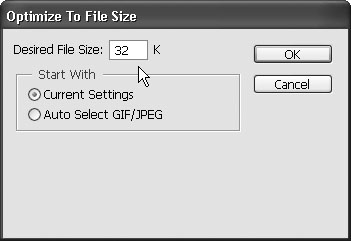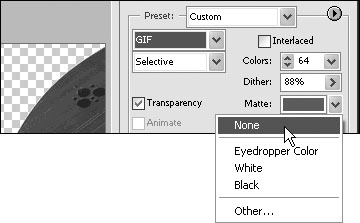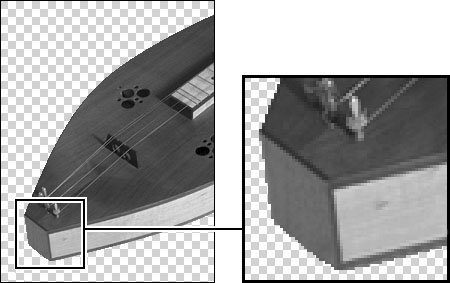12. Preparing Images for the Web
The odds are pretty good that at some point you’re going to want to post your images on a Web page. Whether you decide to post a snapshot of an old push mower to an Internet auction site or just want to send vacation photos to your Aunt Ruth, the considerations are pretty much the same.
Size and speed influence most decisions regarding image preparation for the Web, and they are the central themes of this chapter. The goal of virtually every step of every procedure that follows is to make your images as small and compact as possible. That’s not to say we’re abandoning aesthetics altogether—after all, there’s little purpose in uploading a photograph that’s too fuzzy or distorted to be seen clearly. So although this chapter focuses on creating small, easy-to-download images, it’s also about creating compact files that look good.
If you’re looking to post a gallery of photos instead of optimizing and saving images one at a time, see Chapter 15, “Sharing Your Images.”
Understanding Image Requirements for the Web
Preparing images for publication on the Web presents its own unique set of challenges. Because many Internet users still depend on dial-up connections (as opposed to high-speed DSL or cable connections), an image’s file size is of primary concern. Your image needs to be small enough to download quickly while retaining enough information to display the colors and details of your original image. (Even if your audience is on high-speed connections, it’s a good idea to minimize the size of images so you’re not pushing extraneous bits across the network if you don’t have to.)
Photoshop Elements helps you accomplish this digital sleight-of-hand through a process called optimization. Optimization pares down and streamlines an image’s display information based on variables that you select and control. By limiting the number of colors in an image, or by selectively discarding pixels that are less critical than others, Elements simplifies an image and reduces its file size. Once an image has been simplified in this way, it is optimized (Figure 12.1).
Figure 12.1. The original illustration of the Chinese fan (left) contains a great deal of detail and subtle gradations of tone and color. The optimized version (right) is greatly simplified and contains far less color and image information.

Photoshop Elements offers four file format options for optimizing an image: JPEG, GIF, PNG-8, and PNG-24. Generally speaking, JPEG and PNG-24 are most appropriate for images that contain subtle transitions of tone and color (like photographs), whereas GIF and PNG-8 are best for graphics or illustrations containing a lot of flat color or typography (Figure 12.2).
Figure 12.2. The photograph on the left, with its subtle and varied tones and color, is a good candidate for JPEG optimization, whereas the flat, bold colors and use of typography in the illustration on the right make it more appropriate for GIF optimization.

About the Save for Web Dialog
The Save for Web dialog might be more appropriately called the “Prepare Web Images” or “Optimization” dialog. Within it, you’ll find all the tools, drop-down menus, and text fields necessary to transform any digital photograph, painting, or illustration into a graphic suitable for distribution on the Web.
The original and optimized image previews, the heart of this dialog, provide instant visual feedback whenever even the smallest setting adjustment is made. Information fields below the image previews constantly update to reflect the current optimization format, file size, and download times. And at any time in the optimization process, you can preview and verify exactly how your image will appear in any Web browser loaded on your computer.
Optimizing an Image for the Web
With the Save for Web command, Photoshop Elements provides a simple, automated method that not only saves an optimized copy of your original image, but also preserves the original high-resolution image, untouched and intact. Simply choose from a list of 12 predefined settings, and your image is instantly optimized for the Web. You may want to experiment with the custom optimization settings, but the 12 predefined settings should satisfy the requirements of most of your optimization tasks.
To save an image for the Web
1. Open the image you want to optimize.
2. From the File menu, choose Save for Web (Figure 12.3), or press Alt+Shift+Ctrl+S. The Save for Web dialog opens on top of the active image window, displaying the image in side-by-side original and optimized previews (Figure 12.4).
Figure 12.3. Open the Save for Web dialog from the File menu.

Figure 12.4. The Save for Web dialog. The image on the left shows the original image. The image on the right shows a preview of what the same image will look like after it’s been optimized.

3. From the Preset drop-down menu in the Save for Web dialog, choose a predefined optimization setting (Figure 12.5).
Figure 12.5. Choose from the list of predefined settings for JPEG, GIF, or PNG optimization formats.

The various drop-down menus within the Preset portion of the dialog change to reflect the setting you’ve selected (Figure 12.6), as does the optimized preview in the center of the dialog.
Figure 12.6. Once you’ve chosen a predefined optimization setting, the rest of the options change accordingly. Here, the options have automatically changed to reflect the Medium JPEG optimization format.

4. Click the OK button (Figure 12.7).
Figure 12.7. Click OK to save your optimized image.

5. In the Save Optimized As dialog, type a new name for your file and verify that the file type matches the optimization format you chose in the Save for Web dialog (Figure 12.8).
Figure 12.8. Enter a name and destination for your optimized file in the Save Optimized As dialog.

6. Choose a location for your file and click Save.
The Save Optimized As and Save for Web dialoges automatically close, and your optimized image is saved to the location you specified.
Adjusting Optimization Settings
You’re not limited to using predefined settings to optimize your images. You can fine-tune these settings further by using the collection of drop-down menus, check boxes, and sliders available in the Settings portion of the Save for Web dialog. For example, if you want your JPEGs to retain a little more image quality as they’re compressed for the Web, you can change the default quality setting for a Medium JPEG image from 30 to 45, improving its sharpness and detail without increasing its download time. As you make adjustments, refer to the optimized image preview to the left of the Settings column. There, you can see how your changes affect the image, as well as its file size and download time.
To apply custom JPEG optimization settings to an image
1. Open the image you want to optimize, then choose File > Save for Web to open the Save for Web dialog.
2. From the Preset drop-down menu, choose one of the predefined JPEG settings (Figure 12.11).
Figure 12.11. If you like, choose one of the predefined JPEG settings to use as a baseline for your own custom settings.

You don’t have to choose one of the presets, but they can serve as a good jumping-off point for building your own settings. For instance, if you decide that small file size and quick download time are priorities, you might want to start with the predefined JPEG Low setting and then customize the settings from there.
3. Verify that JPEG is selected from the Optimized file format drop-down menu, or if you’ve decided to skip step 2, choose JPEG from the Optimized drop-down menu (Figure 12.12).
Figure 12.12. Optimization formats can be changed at any time from the drop-down menu.
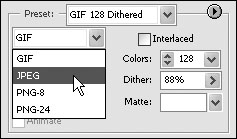
4. To set the image quality, do one of the following:
• From the compression quality drop-down menu, choose a quality option (Figure 12.13).
Figure 12.13. You can choose from five basic quality options for JPEG images: Low, Medium, High, Very High, and Maximum.

• Drag the Quality slider while referring to the optimized preview (Figure 12.14).
Figure 12.14. Once a quality option has been selected, use the slider control to fine-tune it.

The Quality slider has a direct impact on the Quality drop-down menu, and vice versa. When the slider is set between 0 and 29, the level in the Quality drop-down menu will be Low. A setting of 30 through 59 registers as Medium, 60 through 79 as High, and 80 through 100 as Maximum. Just remember that a quality setting in the Maximum range will usually create a file six to eight times larger than one saved in the Low range.
5. Select the Progressive check box if you want your image to build from a low-resolution version to its final saved version as it downloads in a Web browser (Figure 12.15).
Figure 12.15. The Progressive feature draws your image incrementally on a Web page as it downloads, eventually displaying the image in its final state.

This option is more critical for large, high-quality images with download times in the tens of seconds. Rather than leaving a blank space, the low-resolution image appears almost immediately, giving your Web page visitors something to look at until the complete file is downloaded.
6. Select the ICC Profile check box if you’ve previously saved a color profile with your image and want that information preserved in your optimized image.
Unless your photo or art contains some critical color (a logo with a very specific corporate color, for instance), you should leave this box unchecked. Not all Web browsers support color profiles, and the inclusion of the profile information can increase a file’s size significantly.
7. If your original image contains transparency, see “Making a Web Image Transparent” later in this chapter.
8. Click the OK button in the Save for Web dialog to rename and save your optimized image.
To apply custom GIF optimization settings to an image
1. Open the image you want to optimize, then choose File > Save for Web to open the Save for Web dialog.
2. From the Preset drop-down menu, choose one of the predefined GIF settings, or choose GIF from the Optimized file format drop-down menu (Figure 12.16).
Figure 12.16. Choose the GIF setting to optimize illustrations, vector art, or type.

3. From the Color Reduction Algorithm drop-down menu, choose the color lookup table that you want applied to your image (Figure 12.17). (For more information, see the sidebar “About Color Models and Color Lookup Tables” earlier in this chapter.)
Figure 12.17. The GIF format offers several schemes for interpreting and displaying the color in your image.
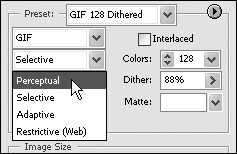
4. From the Colors drop-down menu, choose the maximum number of colors that will be displayed in your image by specifying the number of colors that the image’s palette will contain (Figure 12.18).
Figure 12.18. A GIF image can contain from 2 to 256 colors.

You can choose from the list of eight standard color palette values, use the arrows to the left of the text box to change the values in increments of one, or simply enter a value in the text box and press Enter/Return.
When formatting GIF images, the number of colors you specify will have a larger impact on final file size and download time than any other attribute you set. Naturally, the fewer colors you select, the smaller the image file size will be, so experiment with different values, gradually reducing the number of colors, until you arrive at a setting you find acceptable (Figure 12.19).
Figure 12.19. This illustration was optimized with three GIF color palettes containing progressively fewer colors. From left to right, the illustrations were saved with palettes of 16, 8, and 4 colors, creating file sizes of roughly 32K, 19K, and 12K, respectively.
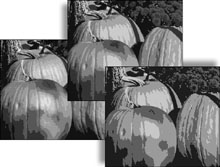
5. Use the Dither slider to specify a percentage for the dither (Figure 12.20).
Figure 12.20. Since diffusion is the default dither option for any GIF image you create in the Save for Web dialog, you can control the amount of dithering that occurs: from 0 to 100 percent.

Higher percentages create finer dither patterns, which tend to preserve more detail in images where limited color palettes have been specified.
Although not accessible from the Save For Web dialog, Photoshop Elements gives you the option to save a GIF image with one of three different Dither options. (For more information, see the sidebar “Choosing Dithering Options.”)
6. If you want your image to build from a low-resolution version to its final saved version as it downloads in a browser, select the Interlaced check box (Figure 12.21).
Figure 12.21. The Interlaced feature works like JPEG’s Progressive option to draw your image incrementally on a Web page as it downloads.

Interlacing a GIF image works in much the same way as applying the Progressive option to a JPEG image. If you choose not to select the interlace option, your image won’t display on a Web page until it’s completely downloaded.
7. If your original image contains transparency, see “Making a Web Image Transparent” later in this chapter.
8. Click the OK button to rename and save your optimized image.
 Tip
Tip
• If you want to save an image in the PNG-8 format, you’ll find that it uses all the same options as for GIF, and the procedures for applying custom PNG-8 settings will be exactly the same as those for GIF. The only options available for PNG-24 are transparency and interlacing.
Making a Web Image Transparent
In just a few simple steps, you can preserve the transparency of any image using options available in the GIF formatting settings. Once transparency has been set, an image of any shape (even one with a transparent cutout) can be placed on a Web page and made to blend seamlessly with its background (Figure 12.25).
Figure 12.25. The image at left was saved with no transparency and displays with a solid, white background. The center image was saved with transparency, but since its matte color was set to the default of white, it appears to have a ghosted halo around its edge. The image at right was saved both with transparency and with its matte color matching that of the Web page background.

To apply transparency to an image
1. Open the image you want to make transparent, then choose File > Save for Web to open the Save for Web dialog.
2. Select any one of the GIF formats from the Preset drop-down menu.
3. If it’s not already selected, click to select the Transparency check box (Figure 12.26).
Figure 12.26. GIF optimization offers the added bonus of preserving transparency in your Web-bound images.
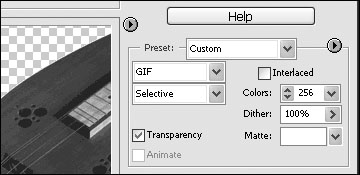
The image in the optimized preview area will be displayed against a transparency grid pattern (Figure 12.27).
Figure 12.27. If the Transparency box is unchecked, the image is displayed on a solid, colored background (left). If the Transparency box is checked, the image is displayed on a transparent background (right).
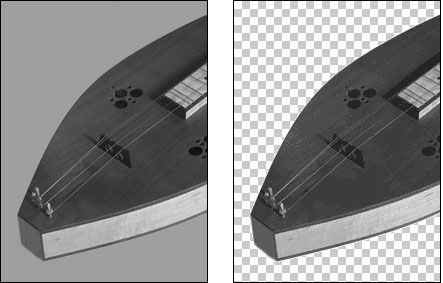
4. To select the color that will be used to blend your image with the Web page background color, do one of the following:
• Click the Matte color box to open the Color Picker; then select a color from the main color window or enter color values in either the HSB, RGB, or Web color space text boxes (Figure 12.28).
Figure 12.28. Choose a matte color from the Color Picker to match your intended Web page background.

• From the Matte drop-down menu, choose a color option (Figure 12.29).
Figure 12.29. The Matte drop-down menu offers a limited number of color options.

Only the semitransparent pixels around the edges of the image are filled with the matte color. If the matte color matches the color of the Web page background, the transition between the transparent image and its background will be seamless (Figure 12.30).
Figure 12.30. The color you select from the Matte drop-down menu or color box fills in the semitransparent pixels around your image, helping to maintain a smooth edge and creating a seamless transition when the image is placed on a Web page of the same color.

 Tips
Tips
• The JPEG format doesn’t support true transparency, but as long as your image is placed on a Web page with a solid, colored background, you can simulate transparency by filling the original transparent spaces with a background color. Follow the steps in the earlier task “To apply custom JPEG optimization settings to an image,” then click the Matte color box to open the Color Picker. Select a color, then click OK. When you close the Color Picker, any areas that were transparent in the original image will be filled with the matte color.
• Since the Eyedropper tool can sample color only from the two preview boxes in the Save for Web dialog, the Eyedropper Color option is helpful only if the color of your Web page background also happens to be present in your image. The Other option simply opens the Color Picker. You’re better off using the Matte drop-down menu only when selecting the White, Black, or None options.
Previewing an Image
Before you commit to saving your optimized image, you should see exactly how the image will appear in a Web browser window. Although the Save for Web optimized preview gives you a good approximation of how the final image will look, there’s no substitute for seeing the image displayed in its natural environment.
Additionally, you can remain within the Save for Web dialog to preview your image as if it were viewed on an older, lower-end system, limited to just 256 colors. This can be helpful, because it allows you to design primarily for most current computer systems while giving you the opportunity to fine-tune your settings to accommodate the limited display capabilities of older systems. Note that this is only a preview and has no affect on your actual image file and its settings.
To preview an image in a Web browser
1. Open the image you want to preview, then choose File > Save for Web to open the Save for Web dialog.
2. At the bottom of the Save for Web dialog, choose a Web browser or click the current browser icon on the Preview In drop-down menu (Figure 12.35).
Figure 12.35. You can open your optimized image directly in a browser for previewing.

The browser opens displaying the optimized image plus its dimensions and the settings you specified (Figure 12.36).
Figure 12.36. When your image opens in a browser, it’s accompanied by all of the settings you specified in the Save for Web dialog.
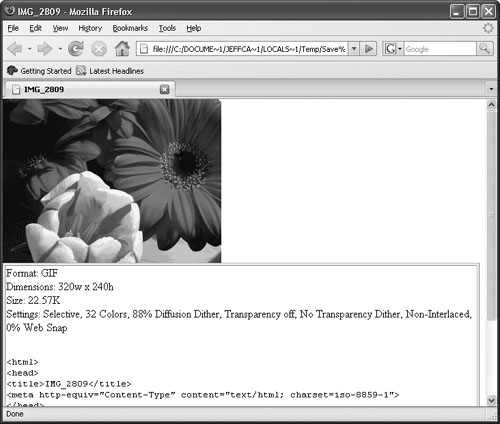
3. Close the browser window to return to the Save for Web dialog.
To preview an image as it would display on older monitors
1. From the preview menu in the Save for Web dialog, choose Browser Dither (Figure 12.37).
Figure 12.37. Select Browser Dither from the preview menu if you want to view your image using a limited Web-safe palette.
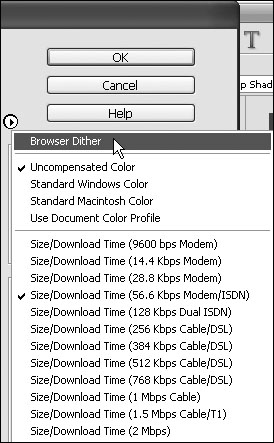
The image in the optimized preview window appears just as it would on an 8-bit (256-color) monitor, allowing you to anticipate what this image will look like on older computer systems (Figure 12.38).
Figure 12.38. When you select Browser Dither, the optimized preview changes to display your image as it would appear on an older, 256-color monitor.

2. To turn off the browser dither preview, choose Browser Dither again from the preview menu.





